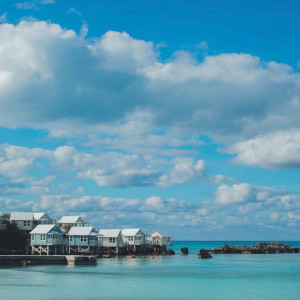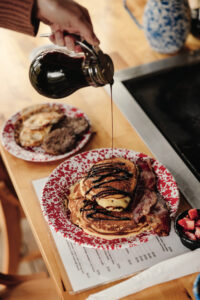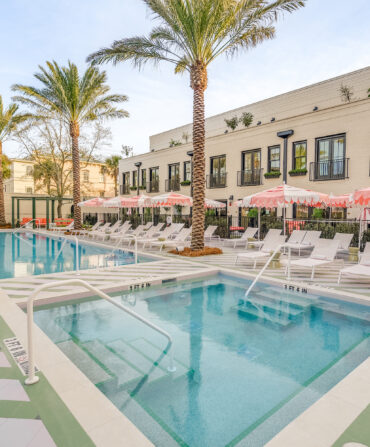Travel
A Winding Trip Through Florida’s Wild Heart
Along the St. Johns river-to-sea loop, historic towns, emerald springs, and cypress wildlands reward the unhurried traveler

Photo: COREY WOOSLEY
Dunlawton Sugar Mill fronds; a Green Springs Park swimmer; hungry folks heed the sign at Old Sugar Mill Pancake House.
In De Leon Springs State Park, just north of DeLand, Florida, I walk toward Old Methuselah, an ancient bald cypress. Lush green ferns unfold at its base, and the towering canopy eats up all available sky space, outcompeting the sweet gums and water hickories growing on the edge of the park’s watery bog. The five-hundred-year-old tree is something of an anomaly: Most pines and cypresses—some of them more than a thousand years old—were harvested as part of the region’s logging economy in the early 1900s. There’s a strange, lovely comfort in knowing that in a state the Spanish dubbed La Florida, the flowery one, moss and vines will cover everything that stands still for too long.

Although I am from South Carolina and teach in Georgia now, I’ve had a relationship with Florida and its subtropical environment for more than a decade, when I began retracing the steps of Zora Neale Hurston. The writer, like me, was interested in Black lives tucked back from the highways of the rural South. Following her adventures has led me deep into the Everglades and on a few quick trips to Eatonville, her hometown, but most of Florida’s wild core has remained a mystery to me. This trip, I plan to fill in that section of my map by roughly following the St. Johns River-to-Sea Loop, a 260-mile patchwork of roads and trails linking the coastal towns of northeast-central Florida to lakes, pristine natural springs, and the cypress-lined river.

Photo: COREY WOOSLEY
The Floridian’s Evening Redness in the West cocktail; bar seats await at the St. Augustine restaurant; citrus-glazed coconut cake for dessert.
I use as my launchpad the historic city of St. Augustine, which sits at the northern pole of the St. Johns loop. I’m not roughing it—at the Floridian, an art-filled and buzzy restaurant with warm wood accents and poppy wallpaper, I kick off the trip with dinner and a cocktail: the Evening Redness in the West, a beet shrub with a bit of rye whiskey. In the brick-lined downtown, I’m staying in the charming Collector Luxury Inn & Gardens, which blends the indoors and outdoors elegantly, and where a bell and a plaque mark the moment when in January 1863, the Emancipation Proclamation was read aloud in the same lush courtyard where I eat breakfast each morning. A nightcap at the inn’s bar rewards me with a perfect Moscow mule, St. Augustine style—vodka infused with locally revered datil peppers from Sailbird, a nearby craft distillery.

Photo: COREY WOOSLEY
The Collector Luxury Inn & Gardens’ Murat House; the inn alfresco.
The next day I drive straight down the coast toward New Smyrna Beach and the loop’s southern section. Along the way, I brake in Port Orange at the nineteenth-century Dunlawton Sugar Mill site. Enslaved people labored here, doing smoky, hot, treacherous work. Poetically, and a little eerily, what’s left of the operation—crumbling brick chimneys and coal-black iron kettles—is covered in succulents and ferns. As I step down from the platform built around the ruins, flowers rise up to break the emotional weight. Orchids dance on the edge of my vision. On the way out, dinosaurs crafted from chicken wire and concrete see me off—in the 1940s, this place was reinvented as Bongoland, a short-lived theme park and someone’s attempt to turn it into something else. Nature won.
Reaching New Smyrna Beach just a little farther south, I meet a wonderful storyteller, Sonya Hogan, at the red-roofed Mary S. Harrell Black Heritage Museum, and she sets the early-1900s scene for me. “This town was a thriving entity,” she explains as we walk from case to case. “We had four or five grocery stores, beauticians, our own cab service. Florida East Coast Railway had passenger trains, and New Smyrna was one of the major stops.” Hogan explains how this section of Florida was a vacationer’s paradise, where the railroad lines that cut through the orange groves and cattle land brought well-heeled travelers seeking rejuvenation at the storied springs nearby. New Smyrna is still a draw for chill seekers today, especially for the walkable downtown, lined with art galleries, and the nearby dunes of Canaveral National Seashore along the southernmost part of the St. Johns River-to-Sea Loop.
The little whistle-stop of DeLand sits inland, due west. Leaving New Smyrna, I grab a chai and bagel with lox at Botanical House, part plant store, part café, and head there to experience a recently inaugurated addition to the network of routes, the DeLand Black Heritage Trail. Landmarks I spot while strolling the trail downtown include the James W. Wright Building, once a hub of Black businesses, and not far away, the former Booker T. Washington Movie Theater, which now hosts a church.

Photo: COREY WOOSLEY
John Merchant’s A Mother and Child sculpture in DeLand; the Mary S. Harrell Black Heritage Museum in New Smyrna Beach.
I pause at the colorful murals framing Painter’s Pond, images showing how the railroad played an important part in the culture, and how the people here made their living working in citrus groves and lumber mills. Just a mile away, the Dr. Noble “Thin Man” Watts Amphitheater, accented with eye-catching yellow and green hues, honors the native son, a saxophonist big in the 1950s, when he accompanied acts like Chuck Berry and Dinah Washington. Every year—usually in February—a jazz fest fills these streets with music, commemorating his life and legacy, giving youths in the area the opportunity to perform, and bringing the community together to celebrate the spirit-filled genres of blues, jazz, and gospel.
DeLand and much of the surrounding Volusia County are part of a still-evolving section of the loop called the Spring-to-Spring Trail. As I ramble the walking paths at nearby Green Springs Park, I realize I have never seen water this color, like an emerald stretched thin. It’s almost translucent, and magnificent live oaks hover just above. I think about a passage in Hurston’s Dust Tracks on a Road, her 1942 autobiography with recollections about her Florida upbringing: “Nothing that God ever made is the same thing to more than one person. That is natural. There is no single face in nature, because every eye that looks upon it, sees it from its own angle.” Every time I think I understand this landscape, something shifts—the shadows, the sunlight. Sometimes even a cool breeze is enough to change the scenery, animating the trees and reorienting the beauty.

Photo: COREY WOOSLEY
The Collector’s pool; coquina stonework in St. Augustine; artwork by Jules Buck Jones at the Floridian.
I drive back north into De Leon Springs State Park, and then, famished, I beeline for the popular Old Sugar Mill Pancake House. The wait for a table often takes more than an hour, but by some miracle, I am seated immediately and revel in my luck, until I realize I have to cook my pancakes myself. As the waitress flips on the griddle, I wonder if it’s too late to run. “If those guys can do it,” she says, thumbing toward a table of middle-aged men transferring pancakes to their plates with ease, “you can do this.” I gulp and ask for the multigrain batter, bacon, and two eggs over easy, please. “Oh, we bring the eggs to you, too, and you cook them how you want them,” she says, tossing her burgundy hair over her shoulder.
After buttering the griddle, I plop down the thick batter. I stand up and attempt to figure this out, as if a bird’s-eye view and additional leverage are going to help me understand when to flip my blob. The eggs don’t fare much better, but my efforts are edible—the pancakes are nutty, a little sweet, and fluffy. Who cares if they’re ugly? Undone by something so simple, all I can do is laugh. On the way out, I purchase a packet of the signature mix to take home so I can try again in my own kitchen.

Photo: COREY WOOSLEY
An Old Sugar Mill Pancake House breakfast gets a finishing molasses drizzle.
Back at the nearby spring, I board a boat tour that winds along the waterways and canals that feed into the St. Johns River system, which is responsible for all the life along this corridor. Catfish, bass, pike, and panfish entice the cormorant watching the water. Other birds emerge from the understory, herons and egrets perched above us, curious. Captain John shares how Florida’s hydrogeology allows this place to flourish. “There’s between nineteen and twenty-two million gallons of water flowing out of the Florida aquifer system every day,” he says as we pass the head of the springs. The intensity of that pressure creates a waterfall of sorts, spouting cool clear fresh water that carved its way across the land. The vast spring also serves as cold storage, connecting our current moment with the prehistoric past: Deep at the bottom, divers have discovered six-thousand-year-old dugout canoes, the oldest in the Western Hemisphere.
I’ve long been fascinated by the hands that worked this scrubland, and those who wrestled with the power of the water. I think often of those who wrote about it, and those who had good ideas but stood still for too long and got covered in vines. After the boat ride, when I gaze up at Old Methuselah, I recall Hurston’s words in Mules and Men: “…the woods…full of magnolia, pine, cedar, oak, cypress, hickory and many kinds of trees whose names I do not know. It is hard to know all the trees in Florida.” But no matter how many visits it takes, it will always be worth trying.







